Exploring the Richness of Chapati Recipes Worldwide


Intro
Chapatis are more than just flatbreads; they are a cornerstone of culinary heritage in many cultures. These simple yet versatile grains offer a delectable taste and texture, making them a beloved staple from the Indian subcontinent to East Africa. As we embark on this exploration of chapati recipes, we’ll uncover layers of history, skillful techniques, and the health benefits they bring to our tables.
Understanding the value of chapati goes beyond mere sustenance. They hold stories, forge connections, and serve as a canvas for delicious pairings. Whether you’re a seasoned cook or just starting out, the beauty of chapati making lies in its simplicity and adaptability, which is why it is cherished by many.
In this guide, we will break down the process from selecting the right ingredients to enjoying your freshly made chapatis. Each section is aimed not only at educating but also at inspiring creativity in your culinary journey. So rolling up our sleeves, let’s dive right into the nuts and bolts of chapati making, beginning with the essential ingredients.
Cultural Significance of Chapati
Chapati, a simple assortment of flour and water, has managed over the years to embody more than just a staple food in many cultures, especially in India and surrounding regions. It reflects the rich tapestry of people's lives, encapsulating not only their culinary practices but also their social, economic, and cultural realities. Understanding its significance enhances our appreciation of this humble flatbread not merely as food but as a symbol of nourishment and heritage.
Historical Context
Diving back in time, chapati doesn't just pop up out of nowhere; it carries with it a deep-rooted history linked to various civilizations. This unleavened bread goes back thousands of years, with traces found in ancient texts and archaeological findings across the Indian subcontinent. It soon became a principal aspect of the daily diet due to its ease of preparation and nutritiousness, especially in times of economic hardship when more extravagant meals were impractical.
As history unfolded, chapati’s role expanded, finding its way into the hearts and stomachs of many households. Some folks have even coined it as a ‘peasant’s bread’ because of its widespread popularity among the working class. Its ability to adapt became apparent; chapati surged as a key player during famines, serving as a nutritional lifesaver. This background contributes immensely to its cultural layers as a food that, despite its simplicity, stood the test of time and various adversities.
Chapati in Traditional Celebrations
Chapati doesn't stop at just daily meals; it also takes center stage during festive occasions and traditional celebrations. Whether it’s a wedding feast in a North Indian village or a family gathering during religious festivals, chapatis play a crucial role. Many cultural practices emphasize serving hot chapatis alongside well-cooked curries or gravies, making them a staple symbol of hospitality and abundance.
In festivals like Diwali, chapatis find their partners in a myriad of rich, flavorful dishes, signifying prosperity and community. Each fold and shape of the chapati tells a story of shared gatherings, laughter, and love over the dining table.
- Significant Events:
- Weddings
- Religious festivals
- Family reunions
Interestingly, chapati varies not only in form but also in the types served depending on the region and community. In some areas, unique styles or flavors are crafted specifically for particular celebrations, showcasing the creativity and adaptability of this fundamental bread. Thus, it's not merely food; it's a cherished link binding people together.
In essence, chapati transcends being just a flatbread; it weaves through the fabric of history and connects generations, enriching lives far beyond the meal it sustains.
To sum it up, understanding the cultural significance of chapati grants insight into how this simple food has influenced and resonated with countless lives, depicting an engaging story of resilience, adaptation, and community. The next time you prepare chapati, consider not just its delicious texture and taste, but the vibrant historical and cultural stories that fill each bite.
Ingredients: The Building Blocks
When it comes to making chapatis, the ingredients serve as the very foundation of this dynamic dish. While the methods of preparation may vary, the components you choose significantly impact the final result. From the type of flour used to the subtle balance of water and salt, each element plays a crucial role in determining not just the texture, but also the flavor and nutritional value of chapatis. A solid understanding of these ingredients can turn a simple chapati into something extraordinary.
Flour Varieties
Whole Wheat
Whole wheat flour is a staple for traditional chapatis, serving as the bedrock of flavors and nutrients. Its key characteristic is its high fiber content, which aids digestion and promotes overall health. This variety retains the bran and germ of the wheat kernel, featuring a nuttier flavor and a denser texture compared to refined flour. Whole wheat chapatis are not just a healthier option; they provide a feeling of fullness that can help in controlling appetite.
However, it can be a bit trickier to handle, as whole wheat dough can be more sticky and dense during the rolling process. But for those who embrace it, the reward is a nutritious chapati that speaks to heartiness and tradition.
Multigrain
Multigrain flour is another wonderful option that brings a lot to the table, literally. As the name suggests, it incorporates various grains like barley, millet, and flaxseeds. The unique feature of multigrain chapatis is their diverse range of nutrients, providing a powerhouse of vitamins and minerals in each bite. They offer a robust flavor profile and a chewy texture that many find irresistible.
In terms of drawbacks, some may find it too dense or rustic, particularly if one is used to the delicate softness of regular wheat chapatis. That said, multigrain chapatis can elevate a meal by not only being healthier but also visually appealing with their multicolored speckles.
Gluten-Free Alternatives
For those navigating gluten sensitivities, there’s no need to feel left out. Gluten-free alternatives, such as chickpea flour, rice flour, or almond flour, can be made use of for chapatis. The standout aspect of these alternatives is that they allow individuals with dietary restrictions to enjoy a cherished staple.
Each type of gluten-free flour brings its unique flavor and texture to the mix. For instance, chickpea flour, known for its earthy taste and high protein content, can make a distinctly different, yet equally satisfying chapati.
However, these alternatives might require specific recipes and sometimes need additional ingredients, like binders, to achieve the right consistency. The resulting chapati may not have the same elasticity one seeks in a traditional wheat chapati, but with finesse, you can create deliciously unique versions that cater to dietary needs without the compromise of taste.
Water and Salt Proportions
The simple combination of water and salt deserves careful consideration as these are essential for the dough’s cohesion and flavor.
Water plays a vital role in gluten formation, helping to create the much-needed elasticity in the dough. The right amount of water ensures that the dough isn’t too dry or too sticky, striking a balance that makes for easy rolling and cooking. Most commonly, a ratio of one cup of water for every two cups of flour is a good starting point, though this can vary depending on the flour's type.
Salt, while seemingly a minor player, is pivotal for enhancing flavor and controlling yeast activity during fermentation processes (if any are applied). A pinch of salt not only helps balance the dish but also preserves the dough. However, it must be used judiciously; too much can overpower the natural flavors of the chapati.
"Remember, the simplest ingredients often yield the most profound experiences."
Getting the mixture just right will result in a dough that is easy to work with, leading to chapatis that are soft, pliable, and bursting with flavor. Careful attention to these fundamental elements sets the stage for crafting excellent chapatis, reflecting both tradition and your individual flair.
Preparation Techniques
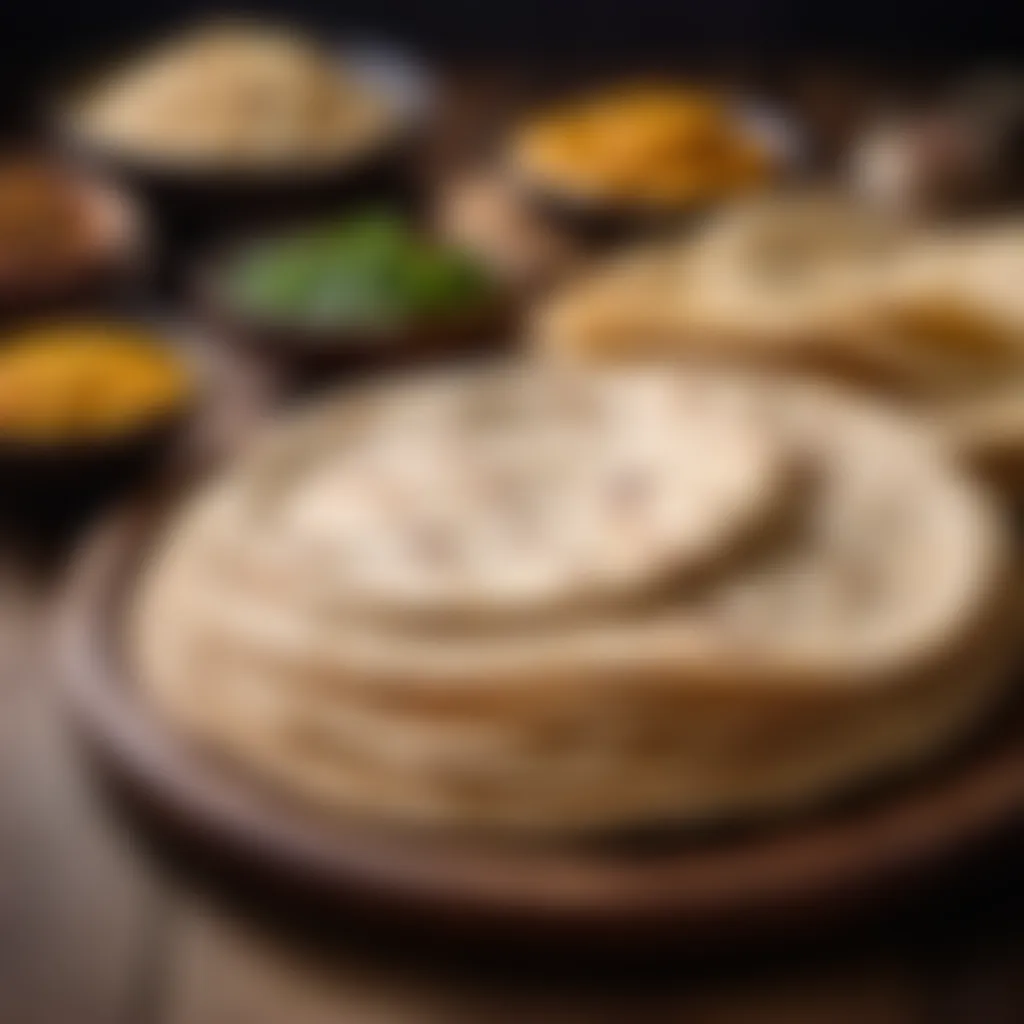

Preparation techniques are the backbone of any good chapati, influencing both its texture and flavor. Understanding how to knead and roll the dough properly can make or break the final product. It’s not just about getting it on the skillet; it’s about creating a product that is soft, pliable, and ready to accompany a variety of dishes. This section explores vital methods that enhance the quality of chapatis, equipping home cooks with essential skills they can apply in their kitchens.
Kneading Methods
Kneading is a fundamental step in making chapati, as it affects gluten development, which contributes to the desired texture. Different methods yield various results and suit different lifestyles.
Traditional Hand Kneading
Hand kneading isn’t merely a method; it’s an art. Many experienced cooks argue that there’s something special about the touch of a hand. When you knead by hand, you can feel the dough and adjust accordingly. This method encourages a connection with the food that can enhance the cooking experience.
- Key characteristic: The ability to adjust moisture and flour ratio on the fly.
- Advantages: It allows for greater control over the dough’s consistency, leading to chapati that are soft and tender. Also, it tends to develop more flavor as you incorporate air while kneading. However, it can be labor-intensive and time-consuming, requiring a bit of elbow grease.
"The secret lies in feeling the dough. Too dry? Add a bit of water. Too wet? Sprinkle more flour."
Using a Stand Mixer
For those who are pressed for time or have physical limitations, a stand mixer becomes a trustworthy ally in chapati preparation. This method caters to modern conveniences, allowing for quick and efficient kneading.
- Key characteristic: It removes the physical effort involved in hand kneading.
- Advantages: Consistency is a major plus. The dough is mixed thoroughly, ensuring even development of gluten. One downside, however, may be the loss of personal touch; some argue that it lacks the care and connection found in hand kneading.
Rolling Techniques
Once the dough is prepared through kneading, the next step is rolling it out. Proper rolling techniques ensure that chapatis cook evenly, which is fundamental for both texture and taste.
Achieving the Right Thickness
Rolling chapatis to the correct thickness is crucial. If they’re too thick, they may remain undercooked in the middle; too thin, and they might burn or become crispy instead of soft. Finding the sweet spot can involve some practice, but once achieved, it’s a game changer.
- Key characteristic: Uniform thickness leads to even cooking.
- Advantages: It reduces the chances of undercooked or overcooked spots, which contribute to an ideal chapati. Remember that everyone’s preference differs—what one person considers perfect might not sit well with another.
Shaping for Uniformity
After rolling, shaping the chapati is a key step. Uniformity not only looks appealing but also affects the cooking process. Uneven chapatis can result in some parts cooking faster than others, which leads to inconsistencies.
- Key characteristic: Ensuring that all chapati are similar in size and shape encourages uniformity.
- Advantages: Maintaining a consistent shape helps in better heating and cooking in a Tawa or skillet. Additionally, it looks more aesthetically pleasing when served.
In summary, mastering preparation techniques like kneading and rolling can transform the chapati-making experience. It enhances not only the quality of the chapatis but also elevates the overall cooking process, making it enjoyable and rewarding.
Cooking Methods Across Cultures
The exploration of chapati cooking methods highlights not just the diversity of preparation styles but also the cultural fabric in which these methods are woven. Cooking chapati is as much about tradition as it is about technique. Each method brings its own unique flavor and texture to the bread, reflecting local customs, available resources, and even the efficiency or convenience of different cooking techniques. While the end goal remains the same—creating a delicious and versatile bread—diving into these various methods can illuminate the rich culinary history surrounding chapati, making the cooking experience more meaningful.
Tawa Cooking
Tawa cooking is perhaps the most traditional method used in many Indian households. It involves using a flat, circular cast-iron griddle to cook the chapati. The beauty of tawa cooking lies in its simplicity; the direct contact with the hot surface creates a lovely char and encourages the dough to puff up beautifully. This technique ensures that the chapati retains moisture while developing a delightful texture and flavor.
When using a tawa, the temperature needs to be just right. If it's too hot, the chapati can burn; too cool, and it won’t puff up. A skillful hand will flip the chapati at the right moment, allowing it to rise perfectly. Additionally, many families pass down secrets on how to best care for their tawa, as it can improve with age. This method embodies not just cooking, but an art form that many home cooks cherish. The satisfying sizzle, coupled with that slightly smoky aroma, creates an ambiance that transforms a simple meal into a cherished tradition.
Using an Oven
While not as common for chapati as the tawa, the oven presents a modern approach to cooking this flatbread. Baking chapatis in an oven can yield an even texture, making it easier to prepare multiple pieces simultaneously. A hot oven can replicate some of the effects of tawa cooking, especially if clay pots are used within it. The technique allows for less hands-on time since the dough can be rolled out and left to cook without constant monitoring.
However, baking chapatis may not develop the same depth of flavor or texture that stovetop methods achieve. The ovens can dry out the chapati if not carefully monitored. Adjusting baking times and temperatures is crucial in this method to yield soft, fluffy bread. For busy households, this might offer a practical way to enjoy chapatis with less fuss, albeit with trade-offs regarding taste and authenticity.
Innovative Cooking Techniques
Grilling
Grilling chapati is a novel twist that introduces a smoky flavor and crisp texture that can be quite delightful. Utilizing a grill allows for a charred effect that can elevate the bread, making it a fantastic companion to rich, flavorful dishes. The key characteristic of grilling is the high, direct heat, which can rapidly cook the chapati, creating an appealing contrast between the tender inside and crispy exterior.
Grilling chapatis is increasingly popular in outdoor cooking settings or among those looking to experiment with flavors. The unique feature lies in the ability to impart a barbecue-style essence that can transform a simple flatbread into a gourmet experience. However, care should be taken to ensure the chapati does not become overly dry. Monitoring the grilling time is essential for achieving the right balance.
Steaming
Steaming chapati presents a different approach that may seem unusual but has its own set of benefits. This method is known for its unique ability to keep the chapati moist and soft, which is particularly favorable for those looking for a lighter alternative. The key characteristic of steaming is that it cooks without direct contact with heat, allowing the bread to retain its moisture without hardening.
Steamed chapati can be exceptionally useful in regions where a softer texture is preferred or where chapatis are traditionally paired with spiced gravies or curries. The unique feature here is the preservation of flavor and nutrition, thanks to the absence of excessive oil or fat used in some other cooking methods. However, steaming may take longer compared to other methods, and it might require special equipment, which is a consideration for those wanting to embrace this technique.
"The method you choose for cooking chapati can be the difference between a rushed meal and a culinary celebration."
In summary, whether opting for the traditional tawa, experimenting with an oven, or trying innovative methods like grilling and steaming, each technique offers distinct advantages and characteristics that contribute to the culinary tapestry of chapati-making. Understanding these methods arms cooks with valuable knowledge to create the perfect chapati vibrantly reflecting their cultural heritage.
Regional Variations
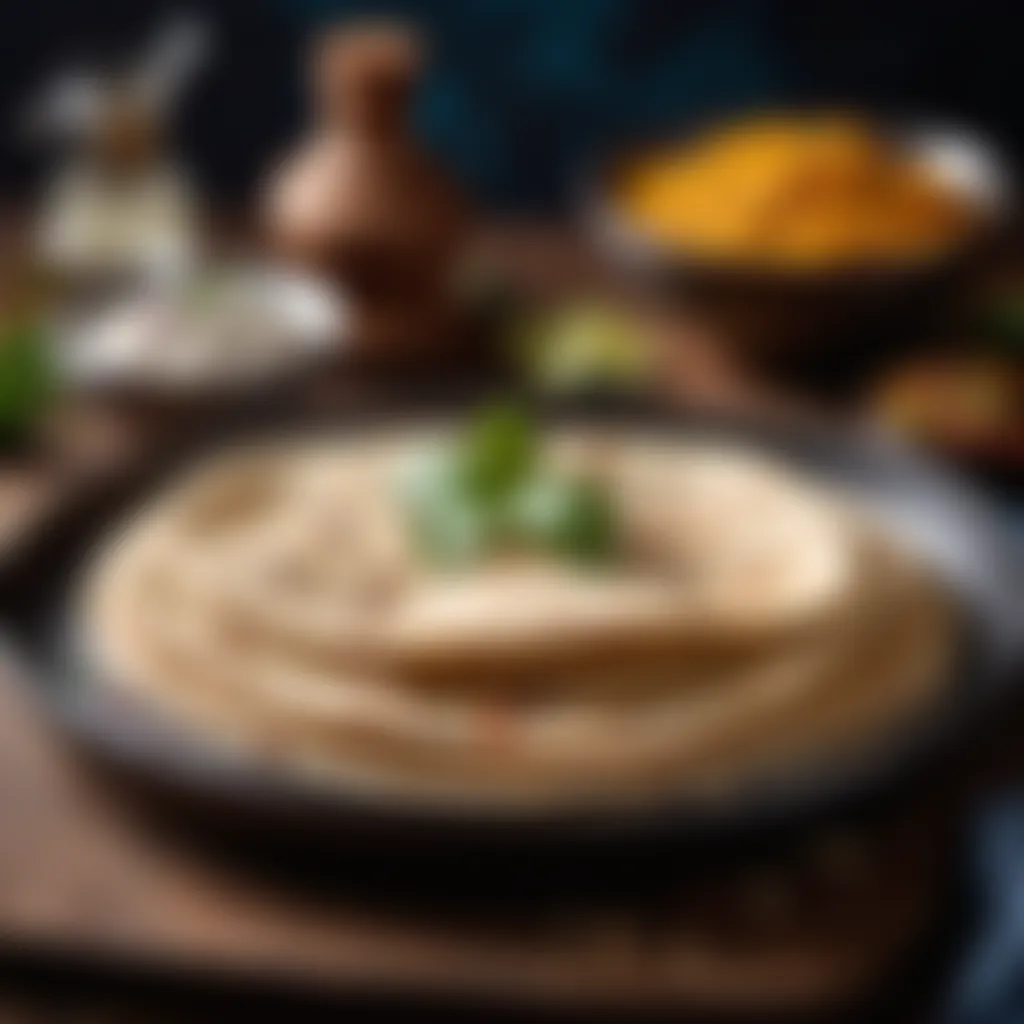
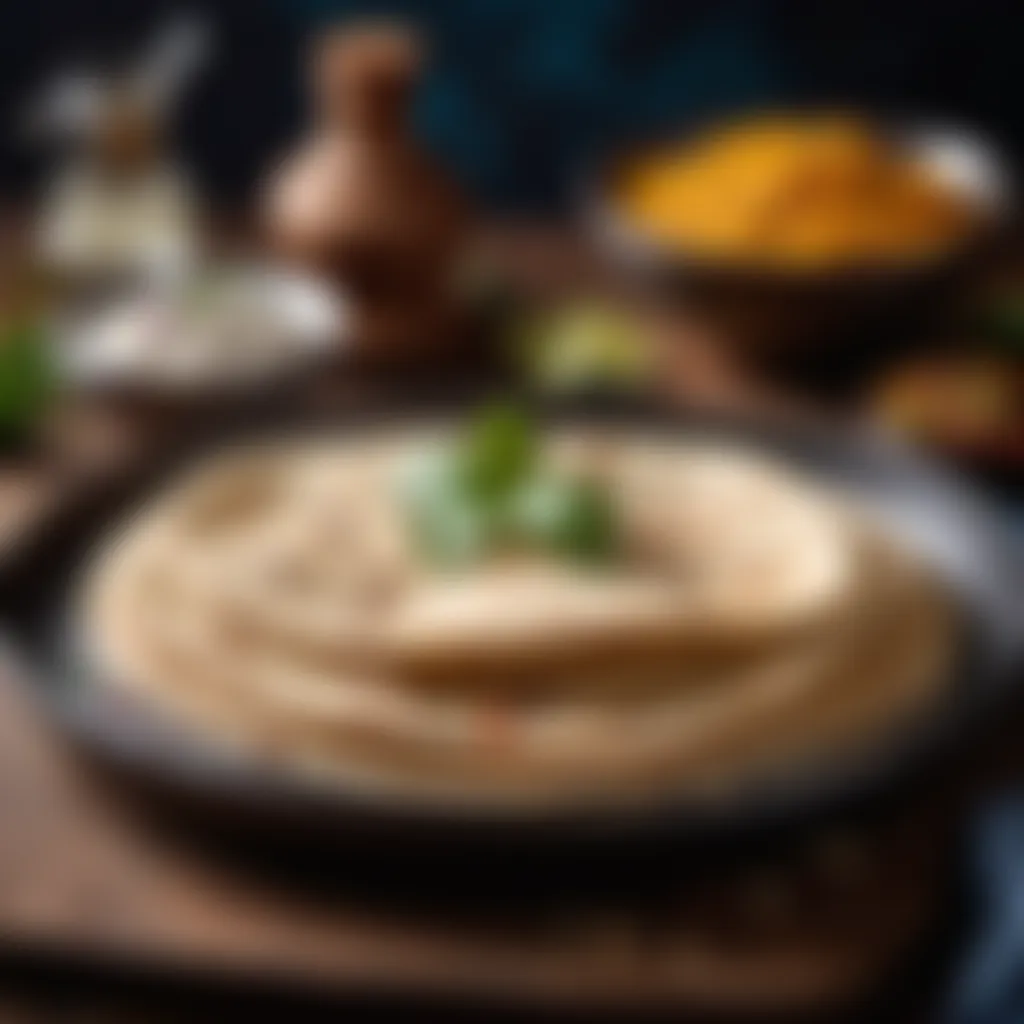
Understanding the regional variations of chapati is essential for grasping the cultural significance and versatility of this staple food. Each region has adapted the chapati recipe to suit local ingredients, tastes, and cooking practices, creating a beautiful tapestry of flavors and textures. The journey of a simple chapati can reveal so much about history, local agriculture, and even social customs. One can consider how the dough is prepared, the grilling techniques used, or even what is served alongside these types of bread. Exploring these variations not only enriches our culinary knowledge but also allows for a deeper appreciation of the world’s diverse food heritage.
North Indian Chapatis
North India prides itself on its soft and fluffy chapatis, often made with finely ground whole wheat flour — commonly known as aata. The dough is typically kneaded with a little salt and water, and sometimes, a splash of oil is added for extra softness. Unlike other regions, chapatis here are cooked on a hot skillet called a tawa, ensuring the perfect cook – golden brown and bubbly.
When served with rich curries like Butter Chicken or healthy dal, chapatis absorb the flavors beautifully. In colder climates, they might often include warming spices. This adaptability allows housewives to create a wholesome meal using straightforward techniques while also engaging the family in a collective dining experience.
South Indian Roti
In the southern part of India, rotis take a slightly different form and are often called phulkas or roti. Here, the dough might include a mix of wheat and a bit of rice flour, resulting in a slightly more textured and chewy bread. The cooking method might include steaming them, making them lighter and fluffier. In addition, coconut and curry leaves can be integrated into the dough to add unique aroma and flavor.
A traditional dish enjoyed with these rotis is sambar or a rich coconut chutney. This combination not only tickles the taste buds but also symbolizes the famous South Indian meal with its vibrant flavors, giving insights into the region's gastronomic identity.
Middle Eastern Lavash
Lavash is a flatbread that exhibits the influence of chapati while rooted deeply in Middle Eastern cuisine. Made from simple ingredients like flour, water, and salt, the dough is stretched into thin sheets that bake quickly either in a clay oven or on an iron griddle.
This flatbread is incredibly versatile. It can wrap around grilled meats, fresh veggies, or savory stews. Particularly in countries like Armenia and Turkey, it's served at meals, signifying hospitality. If you’re looking for a different take on the classic chapati experience, lavash is an excellent option to explore, bringing a touch of the Middle Eastern flavor palette to your kitchen.
African Injera
Injera is a unique type of flatbread native to the Horn of Africa, particularly Ethiopia and Eritrea. This slightly sour bread is made by fermenting a special flour called teff that lends injera its distinct flavor and texture. The fermentation process is key, as it creates a light, spongy bread that pairs excellently with various stews and spices.
Injera serves more than just a dietary role; it is often placed on the table as the main serving dish, with several spicy stews dolloped on top. More than food, it brings family together in a communal experience where each person eats with their hands. For many, making injera is an art that requires practice, showcasing the beauty of culinary traditions.
Each regional variation of chapati not only shows the diversity in cooking techniques but also emphasizes the deep cultural connections tied to food.
While exploring regional variations, one uncovers stories that resonate with history and culture, making every flavor of chapati a celebration of community and heritage.
Pairing Suggestions
Pairing suggestions hold a significant place in the world of chapati recipes. It complements the chapati experience and enhances the overall meal enjoyment. How you choose to pair your chapatis can deeply impact flavor, texture, and even the nutritional profile of your meal. The right accompaniments can elevate simple chapatis into a culinary delight that pleases both the palate and the senses.
When thinking about pairings, consider the balance between richness and freshness. Chapatis are inherently versatile, absorbing flavors beautifully from the dishes they accompany. This makes them an ideal partner for both traditional and modern recipes. Thus, understanding how specific pairings can enhance your chapati meal is crucial.
Traditional Indian Curries
Traditional Indian curries stand as a beloved companion to chapatis. The pairing is not just about sustenance; it’s a cultural marriage that has thrived over generations. Popular varieties like butter chicken, palak paneer, and dal makhani not only complement the flavor of chapati but also offer a nutritional boost. The rich gravies in these curries create a luscious coating, making each bite of chapati a delightful experience.
- Butter Chicken: The creaminess of this curry balances the earthy tones of chapati.
- Palak Paneer: Spinach lends a fresh and slightly bitter element, which harmonizes well with the soft texture of chapati.
- Dal Makhani: A protein-packed lentil dish that feels hearty and satisfying, especially with chapati soaking up its flavors.
"The shared experience of tearing chapati and scooping up curries is more than just eating; it's a dance of flavors, bringing people together."
Dips and Chutneys
Incorporating dips and chutneys into your chapati meal is an opportunity to introduce a spectrum of tastes and textures. The tangy, spicy, or sweet profiles can jazz up even the plainest chapati. Chutneys not only boost flavor but can also add a lovely freshness to the meal.
- Mint Chutney: This provides a cool contrast to spicy dishes and lightens up the meal.
- Tamarind Chutney: With its sweet and sour notes, it enhances the chapati’s flavor.
- Yogurt Dip: A simple bowl of yogurt can be a refreshing side, helping to balance the heat of spicy curries.
The use of dips and chutneys can also introduce a nutritional aspect. They are often made from vegetables, herbs, or fruits, adding vitamins and fiber to your meal. Moreover, they are quick to prepare and can be a fun way to utilize leftover ingredients in the fridge.
Modern Fusion Pairings
Modern fusion pairings are on the rise, showcasing how chapati can fit into diverse culinary scenes. The beauty of chapatis lies in their flexibility. By adapting traditional recipes with global influences, you can enjoy chapati in unique and innovative ways.
- Chapati Quesadillas: Stuffing chapatis with cheese and beans brings a Mexican twist, appealing to both kids and adults alike.
- Chapati Wraps: Using chapatis as wraps for grilled vegetables or spiced meats offers an easy-to-make option for on-the-go meals.
- Chapati Pizza: Topping chapatis with sauce and cheese opens a delightful world of flavors that can cater to various tastes.
These modern pairings highlight the adaptability of chapati beyond its cultural origins. They allow for creativity in the kitchen, making meal preparation fun and enjoyable.
In all, exploring the multitude of options for chapati pairings can transform an ordinary meal into an unforgettable feast.
Nutritional Value of Chapati
Understanding the nutritional value of chapati is key for anyone looking to make healthy meal choices. This staple, made primarily from whole wheat flour, is celebrated not just for its versatility in meals, but also for the benefits it brings to the table. It's crucial to recognize how chapati can fit into a balanced diet while being aware of its limitations.
Health Benefits
Chapati provides a wealth of health advantages that contribute to overall well-being. This flatbread is rich in fiber because it is often made from whole wheat flour. Fiber plays a vital role in digestion, helping to regulate blood sugar levels and keep the digestive system running smoothly. When consumed, chapati can promote satiety, which may help in managing weight.
In addition, chapati contains essential nutrients like iron, magnesium, and B vitamins, particularly when made from whole wheat. Iron is crucial for producing hemoglobin, supporting energy levels. Magnesium aids in muscle function and helps maintain a healthy heart, while B vitamins are necessary for energy metabolism.
"Incorporating chapati into your meals can be a simple way to enhance the nutritional profile of your diet."
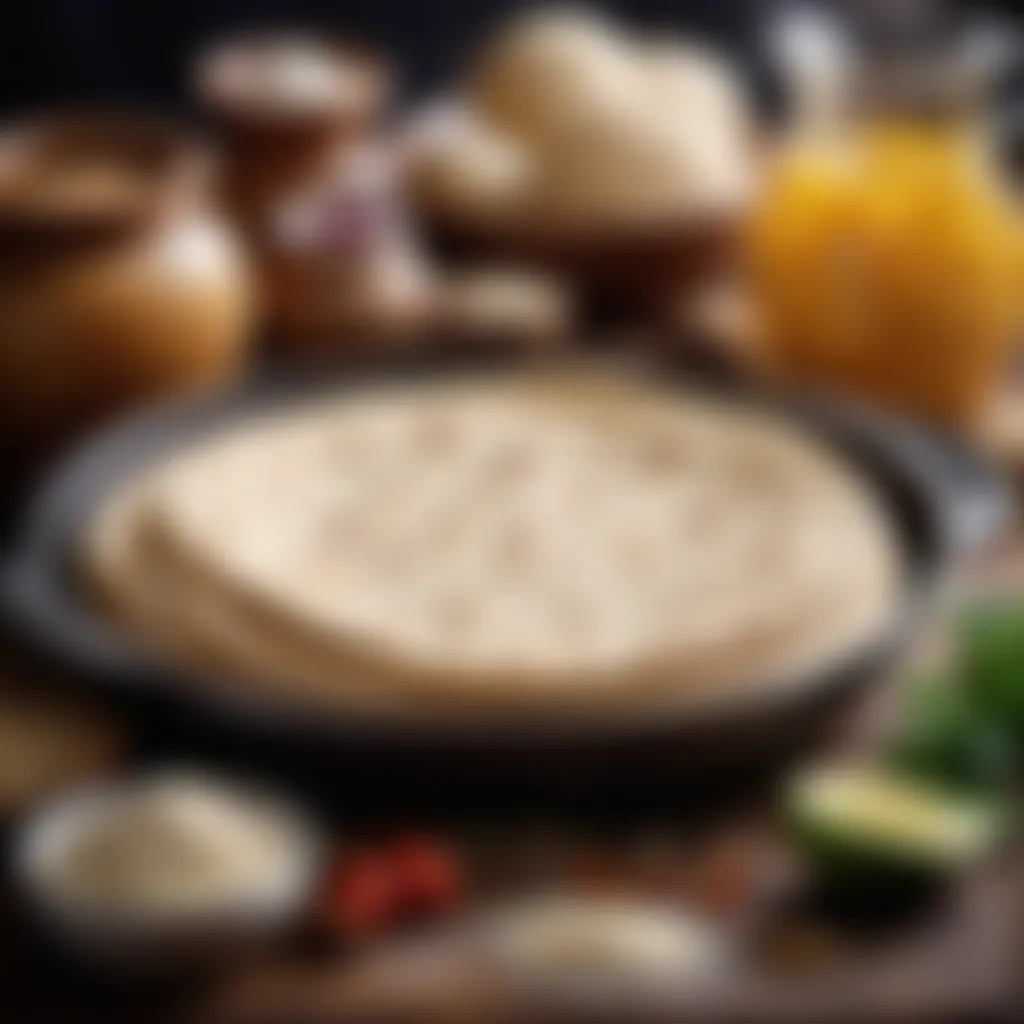
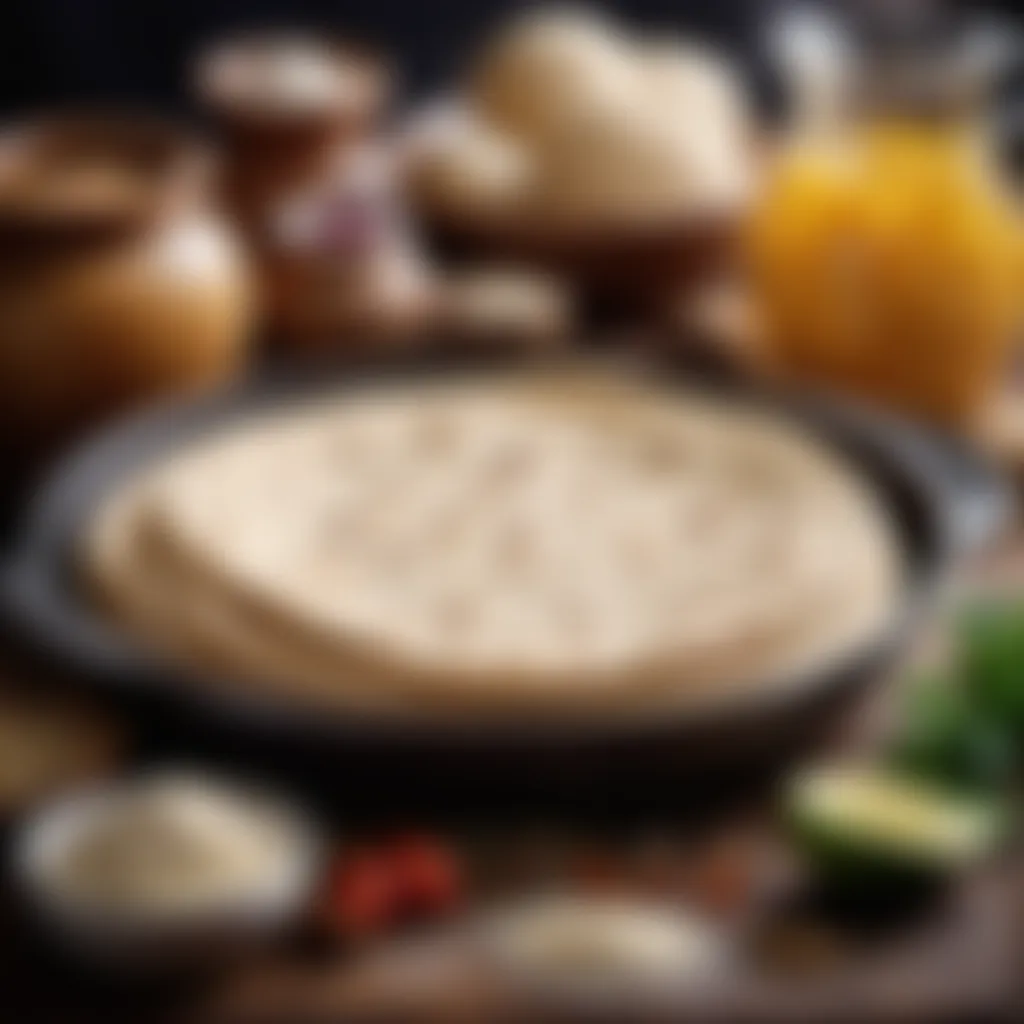
From a practical point of view, chapatis serve as a great base for various toppings and sides, allowing one to create balanced meals filled with proteins and vegetables. For example, pairing chapati with lentils or stir-fried greens can create a well-rounded dish.
Potential Drawbacks
Despite its many benefits, chapati is not without potential drawbacks. For individuals who are sensitive to gluten or have a wheat allergy, consuming chapati can lead to discomfort. It’s important to consider alternative recipes using gluten-free flours such as chickpea or rice flour to ensure that everyone can enjoy this staple.
Moreover, chapatis prepared in excess can lead to excessive caloric intake, especially when used as a vehicle for rich curries or creamy dips. While chapati in moderation contributes positively to one’s diet, overindulgence can counteract its health benefits.
Another consideration is that the nutrient content of chapati can vary based on preparation and cooking methods. For instance, adding fats such as ghee or oil can increase the caloric density, offering flavor but also calories.
In summary, chapati boasts a plethora of health benefits, but awareness of its limitations and mindful preparation choices play a significant role in optimizing its place in your diet.
Innovative Chapati Recipes
Innovative chapati recipes are vital to this article as they illustrate the versatility and adaptability of chapati in contemporary cooking. In an age where fusion cuisine is making waves, chapati remains a canvas for creative expression. This section dives into unique and imaginative ways to prepare chapati, highlighting benefits like increased flavor, enhanced nutritional value, and the ability to please diverse palates.
Stuffed Chapatis
Stuffed chapatis not only elevate this traditional food but also bring a burst of flavors and textures. They are a perfect way to incorporate more vegetables or proteins into a meal without losing the essence of a chapati.
Vegetable Stuffings
Vegetable stuffings are an excellent choice for stuffed chapatis. They allow cooks to sneak in a variety of vegetables, making this dish both delicious and nutritious. One key characteristic of vegetable stuffings is the flexibility they provide – you can use whatever is in season or lying around in the fridge. For instance, combining spinach, carrots, and cheese yields a delightful filling that can both excite the palate and increase the nutrient content of the meal.
Additionally, it’s common to find chopped onions or coriander mixed in for that extra zing. With vegetable stuffings, the advantage lies in their health benefits; they are generally lower in calories compared to meat-based options and rich in fiber. However, a downside can be that some people might find them less satisfying on their own, often pairing them with a dip or curry.
Meat-Based Variations
On the flip side, meat-based variations of stuffed chapatis can bring a hearty feel to the table. Featuring fillings like spiced minced lamb or chicken, they are particularly popular in regions where meat is a staple. The primary characteristic that stands out here is the robust flavor profile that meat offers.
Including options for seasoned ground meat not only adds a depth of flavor but also a satisfying protein source. From a nutritional standpoint, these variations present more balanced meals but can sometimes be heavier on the stomach. Furthermore, meat-based stuffed chapatis tend to be a hit at gatherings and family meals, serving as a filling option that often disappears quickly. On the downside, the preparation can be lengthy, especially with marinating and cooking the meat beforehand.
Flavored Chapatis
Flavored chapatis create an exciting approach to the classic recipe. By infusing the dough with herbs or spices, you can transform a simple chapati into a culinary delight.
Herb-Infused
Herb-infused chapatis are an appealing variation for those who appreciate the subtleties of taste. Incorporating fresh herbs like mint, coriander, or even basil, not only adds flavor but also enhances the visual appeal of the final product. The aroma alone can draw people to the kitchen.
Herb-infused chapatis are a neat way to sneak extra greens into a meal, making them both useful and delicious, especially when paired with an authentic curry. They provide freshness which other forms lack. On the downside, if not consumed quickly, they might dry out faster than standard chapatis, losing some of that desirable taste.
Spice-Enhanced
Adding spices offers a different approach, leading to spice-enhanced chapatis. This technique embraces vibrant flavors by mixing spices like cumin, turmeric, or chili powder directly into the dough. This not only adds warmth but also depth to the flavors. The key characteristic here is that spice-enhanced chapatis can be a tantalizing accompaniment to simplistic meals, providing a contrast that enhances the overall flavor.
One unique feature is that these chapatis cater wonderfully to those seeking more savory options. However, the caution comes from the fact that if not balanced properly, the spices might overwhelm the natural taste of the chapati itself, making it essential to find just the right mix.
"Flavored chapatis offer a unique window into culinary creativity, showcasing how an ordinary staple can be transformed into extraordinary gastronomic delights."
Integrating these innovative chapati recipes can serve as a bridge between traditional practices and modern expectations, helping the cook to impress their loved ones while reaping the various health benefits.
In sum, experimenting with stuffed and flavored chapatis has the potential to not just enrich meal times but also to encourage culinary exploration – all while celebrating a beloved food that has stood the test of time.
Sustainability and Sourcing
In today’s culinary landscape, the significance of sustainability and sourcing cannot be overstated. With increasing awareness of environmental issues, many are seeking ways to align their cooking practices with greener principles. When it comes to chapati making, focusing on sustainability enhances not only the flavor and quality of the food but also contributes to a healthier planet. Here, we dive deeper into choosing local ingredients and reducing food waste, two pillars of sustainable chapati preparation, and explore how they can transform your kitchen experience.
Choosing Local Ingredients
Choosing local ingredients means opting for what is grown or available in your immediate surroundings. This practice carries various benefits: it supports local farmers, reduces transportation emissions, and often leads to fresher produce. When you select flour for your chapatis, whether it’s whole wheat or a blend of grains, sourcing locally means you are likely engaging with ingredients that retain their nutrients better than those shipped from far away. Furthermore, local bakeries may offer fresh, artisanal flours that add a unique flavor profile to your chapatis.
Moreover, local sourcing often embraces the cultural nuances of your region. For instance, if you reside in a region known for its millets, incorporating millet flour into your chapati recipes not only enhances the dish's taste but also reflects local traditions and agricultural practices.
- Support Local Economy: By choosing local suppliers, you are essentially keeping money within your community, creating a sustainable economic cycle.
- Reduce Environmental Impact: Less travel for food ingredients means a lower carbon footprint.
- Enhance Nutritional Value: Fresh ingredients often have better nutritional density.
Using local ingredients also means you’re in tune with seasonal variations. As such, your chapati recipes can evolve throughout the year, allowing for seasonal vegetables or herbs to be infused into your dishes.
Reducing Food Waste
Reducing food waste is not just a trend—it is a necessity. In the context of chapati preparation, this involves being mindful of the ingredients and the recipes you choose. Food waste can accumulate in various forms, from unused ingredients to leftovers that don’t get utilized. Here are practical steps to be more efficient:
- Use Every Bit: After making chapatis, if you have leftover dough, consider rolling it thinly and baking it into crispy crackers. This not only avoids waste but creates a delightful snack.
- Repurpose Leftovers: Chapatis that have gone stale can be taken and crumbled into khichdi or transformed into a frittata. A little creativity can give new life to what might otherwise be discarded.
"The key to sustainability in the kitchen lies not just in what you cook, but how you choose to use each ingredient to its fullest potential."
- Plan Meals Effectively: Meal planning can greatly reduce waste, as it helps ensure you use every ingredient before it spoils. If chapatis are a staple in your household, ensure they are a part of dishes that will be consumed before the week is out.
By being intentional about reducing waste, we move beyond mere sustenance, creating a relationship with food that honors the resources that go into it. Just as chapati-making reflects a balance of art and science, sustainable practices allow us to navigate our culinary journeys with a sense of responsibility and respect for the environment.







